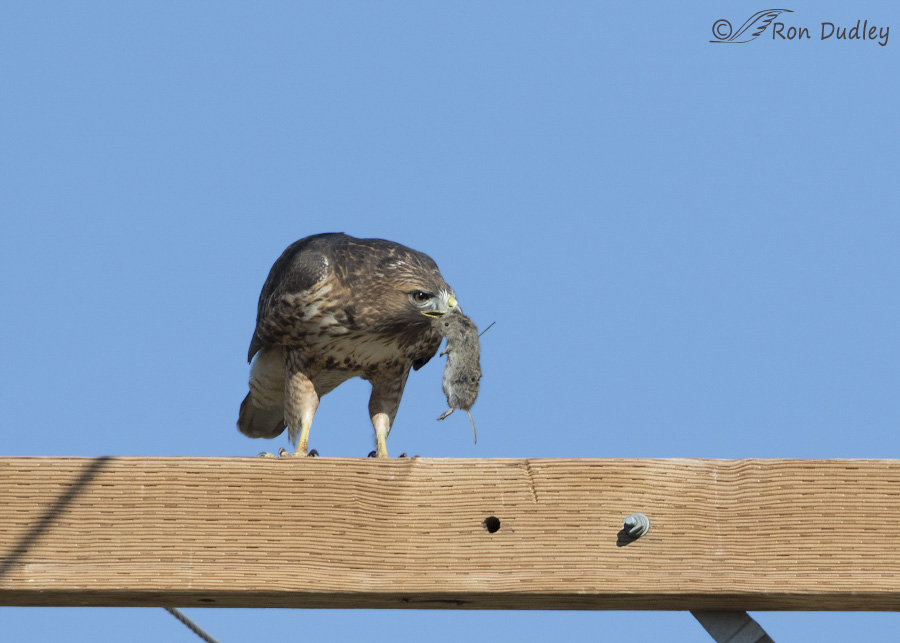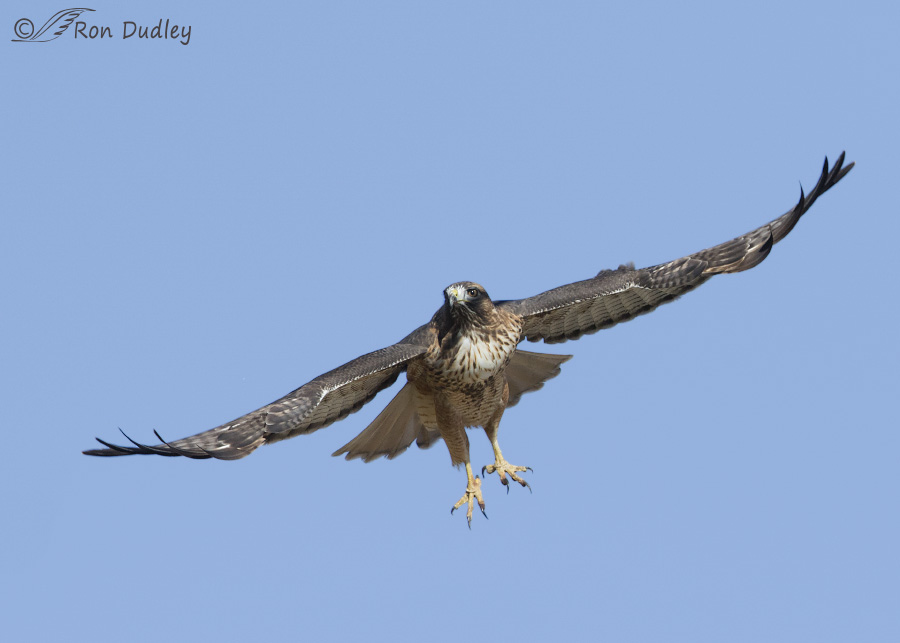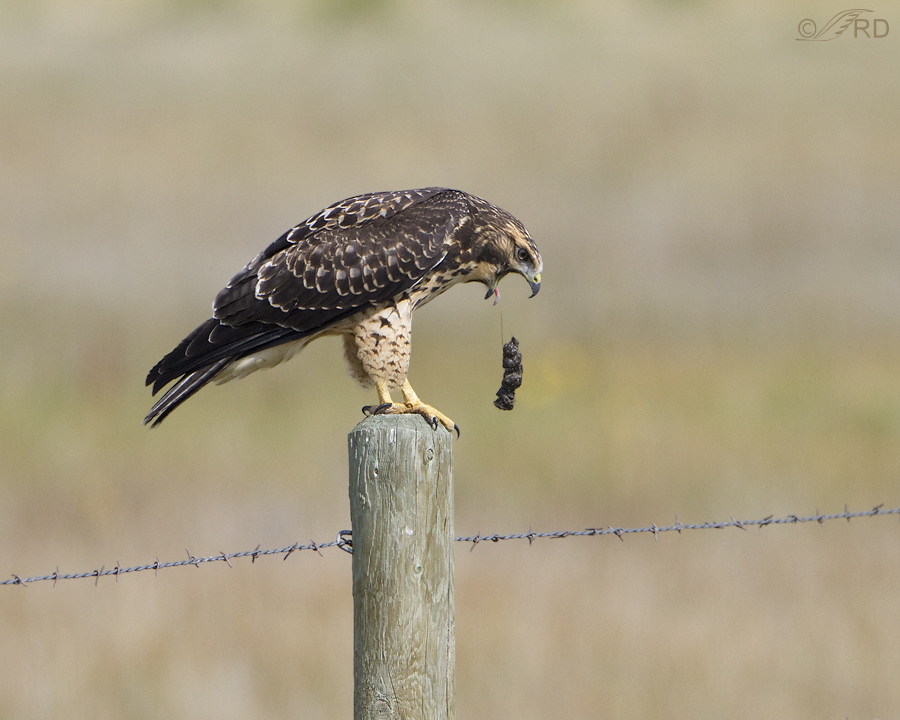Don’t worry, there’s nothing gory in this short “before and after the meal” series. And I’ve also included a bit of a raptor biology lesson.

1/3200, f/7.1, ISO 500, Canon 7D Mark II, Canon EF 500mm f/4L IS II USM + 1.4 tc, not baited, set up or called in
I photographed this Red-tailed Hawk about three weeks ago in Box Elder County, Utah after it returned to a power pole to enjoy its meal of freshly caught vole. I believe the little rodent was still alive when I took this photo but it didn’t take long for the bird to dispatch the vole and consume it. Notice the crop of the hawk. Even at this angle it’s obvious that the crop is empty. In fact it even appears slightly concave and there is no bulge there at all.
When the meal was finished the bird cleaned its bill on the beam of the pole and soon took off. After the vole had been consumed one might assume that there would be no evidence that the vole ever existed but as you’re about to see that isn’t the case.

1/2500, f/7.1, ISO 500, Canon 7D Mark II, Canon EF 500mm f/4L IS II USM, utility pole removed, not baited, set up or called in
This image was taken just as the hawk lifted off (I’ve removed part of the pole so the viewer can focus on the bird). Notice the bulging crop in the area of the upper chest. That bulge was caused by the vole which is still in the crop and hasn’t yet reached the stomach.
The crop is like a pouch along the esophagus where food is initially placed before it reaches the stomach. Food is softened and temporarily stored there.
Diurnal birds of prey (hawks, eagles and falcons) have a crop as do most, though not all, other birds. An amazing amount of food can be stored in the crop which then bulges out from the bird’s upper chest and that can give the raptor the look of a feathered Mae West!
Having a crop provides several advantages to a raptor, including:
- Many raptor species (and other predators) are notorious for stealing the freshly caught meals of birds of prey so the ability to quickly (very quickly) swallow and store food decreases the chances of a meal being stolen (several days ago I watched as a Ferruginous Hawk on the ground swallowed a vole in two bites and about as many seconds. It was a very impressive performance!)
- Storing food in the crop allows raptors to consume a greater amount of prey which provides more nutrition for later
After the food passes through the crop, indigestibles like fur, scales, and insect exoskeletons from the meal are formed into a pellet or casting in the gizzard and the pellet is later regurgitated by mouth. The stomach (where the food eventually goes) of many hawks is so acidic that bones can be digested so their pellets typically do not contain bones.

A Swainson’s Hawk casting a pellet
It’s interesting to note that owls do not have crops. They swallow their prey whole and their food goes directly to the stomach where indigestibles are formed into pellets and eventually regurgitated. Owls cannot digest bones so their pellets typically contain them.
Ok, enough digestion anatomy and physiology. I realize that many of my blog followers are raptorphiles so much of this information is old hat to them. But I thought other readers might find it interesting.
Ron


I’m a raptorphile who can’t get enough of behavioral shots like this. Thank you!
Great post, I too learn a lot from your blog. I am surprised by the old school Mae West reference, I would have thought a young whipper-snapper like you would have gone with Kim Kardashian.
Ken, I actually thought about three examples – Mae West (old school), Dolly Parton (middle school) and Kardashian (elementary school) but I thought West with her ample but squashed together bosoms look (similar to some old-time cartoons) most resembled a raptor with a bulging crop.
And it’s been a very, very long time since I’ve been a “young whippersnapper. Except perhaps in spirit…
Cool pictures!! I’ve always wanted to dissect an owl pellet… I know that there are kits that one can buy, and they sometimes do it at school!! I need to start a skull collection!!
I occasionally had my students dissect them when I was teaching, Nicky. Most of them were fascinated by it but some were a little put off when they thought about where the pellets came from.
Nicky Haller-Wilson BEWARE of the owl pellets you buy online. I couldn’t believe it when a teacher friend told me that most of those kits aren’t owl pellets at all, but manufactured representations!! I mean, who would do that? Yes, I know the answer to that, BUT still. It seems that in our don’t-even-think-about-getting-dirty world, owl pellets are banned. If you want a REAL owl pellet, your best bet is to contact your local raptor rehabilitation/education group. They’ll have a real one–and they’re fascinating! You can often rebuild the skeleton of a small rodent from an owl pellet, except for the life part. Those parts aren’t included
I’ve got a collection of hawk castings–from a redtail hawk, a Harris’ hawk and an American Kestrel, but hawks and falcons can digest the bones so all you have is a wad of fur/feathers, depending on what they’ve eaten. That said, occasionally you get interesting stuff like the exoskeleton of a big bug. Amazing, but those generally come out intact, again, except for the life part.
Ron,
I do not know much about birds so I appreciate the extra info. Thanks, Jami
We all start somewhere in our bird learnin’, Jami. Thanks.
You can retire from teaching, but never from being a teacher. Posts like this make me miss my high school and college biology classes, always fascinating!
Posts like this make me miss my high school and college biology classes, always fascinating!
“You can retire from teaching, but never from being a teacher.”
I guess that’s me in a nutshell, Jeff. Thank you.
Definitely better out than in for the last shot.
Thank you, as always for the beauty and the education. I am never certain which I prefer. My greedy self wants both.
“Definitely better out than in for the last shot”
You have a way with words that I enjoy, EC. Thank you.
The photos, as usual, are awesome – but the digestive portion of this post has me a bit perplexed. Raptors have two ‘stomachs’: the proventriculus or glandular/predigestive stomach and the ventriculus or gizzard/mechanical stomach. It was always my understanding (and I jusat verified this with an ornithologist) that the crop was strictly a holding tank, that no digestion took place there. In my work, I have had to remove crop contents with some regularity with long forceps – and it comes back out looking pretty much the way it did when ingested. Mind you, if something is wrong and it sits in there ‘cooking’ for a bit too long, it smells really rank but it still looks the same. (I particularly can think of removing a couple of snakes from the crop that had been in there too long – and they always look pretty much just like a snake! Same for chunks of vole or bird.) If a bird isn’t emaciated and the GI tract compromised, the food usually moves on down to the stomach(s) over the space of a couple of hours – pretty quickly. The softening and separation of digestive vs non-digestive portions starts with the juices of the proventriculus, but it’s completed in the gizzard with its muscular/mechanical action – and that’s where the pellet is formed (you can feel it when palpating the abdomen). Mind you, I am not a biologist or ‘ologist of any kind, simply a raptor rehabilitator – but this has always been what I’ve read and experienced, including from doing necropsies.
Louise, I guess I’m a little perplexed about part of what has perplexed you about this post…
I never said that digestion occurs in the crop. It doesn’t. Digestion is largely a chemical process where complex molecules are broken down to simpler ones (proteins to amino acids and complex carbs to simple sugars for example) and that occurs lower in the digestive tract.
But you’re right, the actual pellet is formed in the gizzard and I implied that it forms in the crop when I said “the crop separates out indigestibles”. I’ll edit my text to be more accurate.
Thanks for the feedback. I always appreciate your input from the “real world” of rehab and it’s always my goal to be as accurate as possible.
Two things set your blog apart. The first, of course, is your magnificent photography, and the second are the biology tidbits that you share. Thank you for both.
It’s wonderful to know that some others enjoy those “biology tidbits”, Buff. Thanks for letting me know.
Super shots Ron! Interesting info as well, we’re not all raptorpliles.
Charlotte
Thank you, Charlotte.
If you ever worry about still being a “teacher”–just know that I, along with other readers ( responding earlier ) absolutely love receiving the information, as well
as the wonderful images–” Go ahead—(you) make my day ! “
Thanks, Kris – your comment warmed my heart. I still miss being in the classroom but I sure don’t miss the “office politics” and I love my bird photography almost as much as I used to love teaching.
Fabulous series Ron! And thanks for the anat + physio. lesson — well done! I didn’t realize that owls lacked a crop, but now that you point it out-they sure don’t ever look like our Red-tails after they’ve eaten a squirrel–learn something new everyday! Best, Christine
I didn’t realize that owls lacked a crop, but now that you point it out-they sure don’t ever look like our Red-tails after they’ve eaten a squirrel–learn something new everyday! Best, Christine
I’m glad you enjoyed the biology lesson, Christine. Thank you.
1. I thought Mae West had TWO…..
2. If I ever swallowed a vole, dead or alive, I’d throw up, too….
3. Info on function and purpose of the crop was almost all new to me…very interesting! I just knew it had a part in predigestion , little else…fits in with what Jerry told me about big birds being able to go for longer periods before having to “refeul”…i ALWAYS. learn something new from each day’s blog…love it!
Look at some of the old photos of Mae West, Patty. In the style of the day they look like one…
Jerry is always a reliable source of raptor info. His store of knowledge on the subject is almost as impressive as the food-storing ability of the crop of a raptor.
Did you ever see the movie “Never Cry Wolf”. Voles on toast, or roasted over a candle or simply boiled to perfection might be pretty good…
Eating an herbivore is the best food along with a nice salad. lol
Dick…if you ever plan to invite me to dinner….FORGET IT!!!
Oh Patty Chadwick, rodent tartare is delightful–NOT! One of the glamour parts of falconry is that while the birds are generally surgical in removing the innards (the stringy parts like spaghetti), they’ll often sling them at you, hitting your glasses or other assorted body parts. Hate it when they do that!
I saw the movie…Yuk,
I’m fascinated by raptors, and have been since I became aware of them, but this information is all new to me. I haven’t spent a lot of time studying them, so I appreciate this lesson on raptor digestion. I’m always up for learning new things.
“I’m always up for learning new things.”
That’s how we keep young, isn’t it, Susan?
Yes, it is. One of the best parts of being a biologist is that our curiosity never dies. And that enriches our lives tremendously as well as keeping us young.
I did not know about the crop in diurnal raptors…thank you for the info
You’re very welcome, Zaphir.
Great shots, Ron! The Red-tails around the Sacramento Valley certainly depend on the rich vole population. But a falconer friend, who haunts the fields almost daily this time of year, reports a couple juvenile RTs successfully hunting pigeons. That must take some fancy flying! In summer, when the Yolo Causeway on Highway 80 between Davis and Sacramento has a huge population of Mexican Freetail Bats, you can sometimes see an enterprising RT snatching them out of the air. And that is at near dark. What wonderfully adaptive birds these are!
Thanks, Sally. I had no idea that red-tails occasionally hunted bats on the wing. Fancy flying indeed!
BTW, I appreciate your feedback on that older Harlan’s Hawk post and the link provided by one of my readers to an image of a possible Harlan’s he took. Comments are closed on that post (they always are after 10 days in an effort to cut down on my spam) so I can’t add a comment explaining that the bird wasn’t a Harlan’s. But I’m still glad to know. Thank you.
I love redtails–a LOT–and I’ve been privileged to share my life with a petite western female redtail for the past 22 years. Mariah can eat roughly two-thirds of an adult cottontail rabbit in one sitting, and when she’s done that, neither Dolly Parton nor Mae West has anything on that girl, even combined! The bulge can actually expand slightly over the top of their wings (in a perched position) and stick out like a grapefruit. That crop is pretty darn elastic. All they have to do is keep packing it down in there And when they feast like that, it only takes about 12 hours for them to put over (process) the crop contents, but it takes several days for them to get hungry again. That said, they’ll return to the carcass the next day (assuming it hasn’t been pilfered by an owl or other ground critter) to finish it off. You just never know where your next meal is coming!
And when they feast like that, it only takes about 12 hours for them to put over (process) the crop contents, but it takes several days for them to get hungry again. That said, they’ll return to the carcass the next day (assuming it hasn’t been pilfered by an owl or other ground critter) to finish it off. You just never know where your next meal is coming!
With little rodents that are their staple diet (an easy, quick, safe catch–assuming nobody’s poisoning rodents), they’ll either hork ’em down whole OR it’s off with their heads! Critters struggle less with the off-with-their-head strategy. I LOVE redtails–a LOT!
Laura, while I was composing this post I was actually thinking about what you might add to the conversation. And I was not disappointed.
Amazing that you’ve had your red-tail for as long as you have. I can hardly imagine a red-tail packing in 2/3 of an adult cottontail into their crop. What an amazing adaptation!
Thanks so much for your comment.
Interesting Ron. I had never thought of the difference in owls versus hawks and the crop / no crop feature. Great photos. Your image of the Swainson’s Hawk casting a pellet would be perfect for one of those corporate motivational posters
Got a laugh out of the last part of your comment, Ed. Thanks for that!
I agree with Jeff! I’d never thought about raptors having a crop nor the fact owls don’t.
I’d never thought about raptors having a crop nor the fact owls don’t.
Judy, watch for that bulging crop whenever you see a diurnal raptor. It can say a lot about its recent activities and any recent hunting success.
Ah, such a great shot of the Red-tail with its vole.
I watched a Red-tail capture, bring its vole to the top of a bird box in our field, and devour it – oh if I only had a 700 mm lens! lol
Wonderful info Ron, thanks for sharing!!
Thanks, Dick. I took that first shot at an effective 1120mm and still had to crop significantly but thankfully I’d taken off my teleconverter just before the hawk took off or I’d have clipped wings. When those wings come out the size of the overall bird increases explosively!
Great information Ron. “Show and Tell” at its classic best.
Thanks very much, Jeff. “Show and tell” works just fine for me!